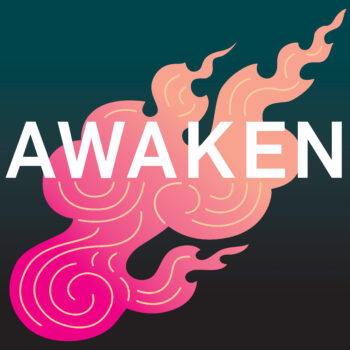
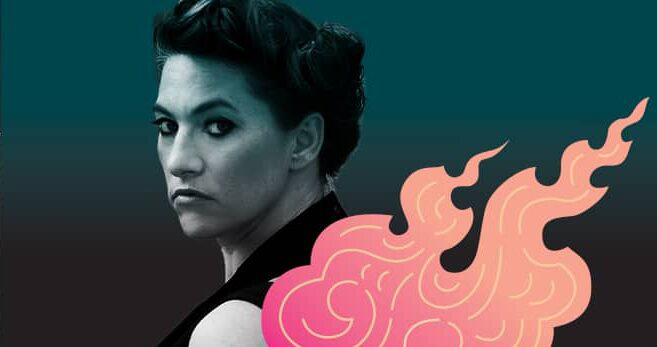
What role does darkness play in the journey toward enlightenment? In this episode, hear about the power of darkness and what it means to embrace it. Musician, songwriter, and best-selling author Amanda Palmer shares the story of her childhood, the trajectory of her life as a street performer to musician, and how embracing her own darkness set her free.
AMANDA PALMER
I was hanging out at a big New Year’s festival that my band was playing in, and I wound up sitting outside and getting into a random conversation with a random guy who just kept repeating, “It’s all good.” And I just remember thinking, like, this is why I’m so angry at hippies. Because I know he’s right at a level, but also you just want to fight back and just be like, argh, there’s all these things that are clearly not all good.
LAURIE ANDERSON
Welcome to AWAKEN, a podcast presented by the Rubin Museum of Art in New York City. That was the voice of Amanda Palmer. And I am your host, Laurie Anderson. In this 10-part series, we explore the dynamic path to enlightenment and what it means to wake up. We’ll hear from authors, artists, wisdom bearers, and Buddhist teachers, people who have experienced a shift in their perspectives on life throughout their personal journey. This podcast is inspired by the exhibition Awaken: A Tibetan Buddhist Journey Toward Enlightenment, which illustrates the stages of enlightenment through paintings, sculptures, and other objects. We use these artworks as a jumping off point to better understand the paths our guests have been on and where they are going. In this episode, we talk about darkness and what it means to embrace it. We’ll hear musician, songwriter, and best-selling author Amanda Palmer share her story of her childhood, her life from street performer to musician, and how she found inspiration embracing the darkness. But first Amanda encounters a painting of the powerful and fierce guardian Yama Dharmaraja.
AMANDA PALMER
I’m now seeing figures that I didn’t even realize were figures. This giant black figure that’s now very obviously the central figure of the painting””I hadn’t even seen that figure. I thought that that blackness was like a field (laugh), which is just so beautiful. Like I’m now looking at it and I can’t unsee what I can now see, sort of like an optical illusion. It’s so obvious to me now that it’s this one big figure, standing on a buffalo. I love the intensity of images like this. It just is very delicious to my brain looking at this. And in fact, there is a photograph of me and my house in Woodstock that is all like red and beauty and balance and skulls and death and darkness and gorgeousness. That reminds me a lot of this Tibetan painting from the Rubin, because it’s like this lush explosion of death and darkness and power.
LAURIE ANDERSON
Yama Dharmaraja wears a crown of skulls and a garland of freshly severed heads. He is surrounded by flames and stands astride a buffalo and human corpse. Here depicted is the fiercest version of wisdom. Within Tibetan Buddhist paintings, wrathful deities often serve as protectors of Buddhist teachings.
AMANDA PALMER
And that’s a really interesting job being a fierce protector as someone who works in nightlife and has met many, many, many bouncers and been both the rejected and the protected (laugh). I’ve been on either side of that. Bouncers can be the most amazing, compassionate, sexiest, most wonderful embracee types of human beings, or they can really be like the fucking worst. You’re talking about the fierce side of compassion, and it is so weird if we have this idea of Buddhism and this idea of compassion, where everything is nice and calm and people are sitting there burning their sage, but those moments exist. But compassion sometimes looks like this picture.
I remember being in the living room. I would close all the doors and then I could be in there alone with big headphones on my head. And I learned how to work the record player by myself when I think I was about six. And I would just sit there on the rug, listening to Sgt. Pepper’s and Waiting for the Sun by The Doors and The Beach Boys. I went to another world, and I loved the music that told stories, and Sgt. Pepper’s,that was a world that I felt invited into. It was a world that made sense to me. I could feel and understand where they were and I could see Rita, the meter maid, and I could see the girl in her twenties leaving home. And I could see this circus of the benefit of Mr. Kite. And I could just like, I was there. I was invited into this world. And I felt the same way about The Beach Boys. Like they invited me to a fair. They invited me to this world of cars and surfboards and beautiful teenagers. And I loved that world. I wanted to be there. I would put on those records and I would go there.
And then 10 feet away from the stereo was the piano. And I wandered over to that piano and started picking out songs and teaching myself how to play. And I remember from a really young age, like about that old””6, 7, 8, 9, 10. I knew I wanted to be one of the musicians and one of the artists and one of the storytellers who got to create these worlds where you can invite everyone else to come and be there with you. And when I think about my work now and what I’ve done and why I’ve done it and how I’ve done it, I mean, so much of love in the world of those records was a feeling of not being alone. I was a really lonely kid, and I just wanted to not feel and be alone. And I think I imagined at 6 years old, at 9 years old, at 12 years old, I think I imagined that if I could somehow walk through the gate, if I could find that gate and I could get the key and I could open it and I could go be on the other side where The Beach Boys were and The Beatles were, and the doors were, like, this magical place where people got to be artists and musicians. If I could find my way there, then I would never be alone.
When I think back to my childhood and the town I grew up in, you know, everything was very nice. Things were pretty sanitized. And I craved the darkness.
I craved a glimpse into like the dark and the mess and the crazier sides of life. I was obsessed with the idea of punk rock and the idea of Woodstock and crazy dirty hippies and destructive punk rockers and people who were into talking about death and into talking about suffering and into talking about pain. And you know why, I don’t really know, but I venture to guess that it’s because there wasn’t a lot of that on offer in the culture that I was growing up in to the point where things were out of balance. I grew up in a family and in a culture that really glossed over the darker aspects of existence. And I think that left me with a hunger to understand and be connected to the dark because I knew it was there. It was really obvious it was there. Things were dying, people were dying, suffering was happening, pain was happening, but no one was fucking talking about it and I needed to fill that void with something. And so I found that in music. I found it in punk. I found it in goth. I found it in my own expression of self and the way I dressed and looking as sort of like crazy as I could in that kind of punk goth way, almost as a way of like staking a claim in the ground next to what I was seeing in this nice, calm, sanitized suburb. Like I just wanted to shout to the universe. Like I know that that other exists. Like I know that there’s pain and suffering. I know it’s out there. And so I went out and found it and that still shows up in my work all the time.
I was hanging out at a big New Year’s festival that my band was playing. And I wound up sitting outside and getting into a random conversation with a random guy who just kept repeating, “it’s all good.” You know, I’m sure I was drunk. And we were just talking, you know, that he just kept looking and going, “Yeah, it’s all good.” And I just remember thinking, like, this is why I’m so angry at hippies. Because I know he’s right at a level, but also like there is something kind of noxious and sometimes toxic feeling about someone, just looking at you with their sort of glazed over eyes, going, “It’s all good.” Because you just want to go back and just be like, ah, it’s not all good. You know, there’s all this suffering, there’s all this death. There’s fucking, there’s systemic racism. There’s all these things that are clearly not all good. And this is our journey as human beings is to like, walk that tightrope between them. We fundamentally know that, you know, we’re all going to die and this life is a total illusion and it is all good, but also it’s not all good.
You know, there are these ideas bouncing around that, the night people, as our people are sometimes called, the music people who start work at 8:00 PM and don’t clock off until 5:00 AM. We’re kind of in a different world, in a different realm of vice and dirt. And especially if you’re a punk rock person. And vice versa, you know, there’s a real stigma within the dirty, crazy, dark rock and roll world about the yoga people and their bright eyed, clean living, incense burning, you know, all that stereotypical imagery, which we of course know, like if you’re really in a practice like this, you know, that that’s all just bullshit. But the stereotypes persist. And as I moved through my thirties, you know, I’m 44 now, I really started to realize my own compartmentalizing of these little bits of my life and, you know, how I lived in fear that parts of my life were contradicting one another.
It took me a while to realize that, you know, that’s fucking everybody. Everybody I know who has a practice swims in a sea of contradictions and multitudes. And I sort of gradually learned to just drop all of my shame about that and just stop hiding anything. And literally just talked about what I was interested in and followed my curiosity. And if my curiosity led me at a certain point to, you know, to sort of be in the dark world of crazy rock and roll for this moment, great. If it led me to be sitting there and sort of looking like a yogi the next moment, great. And you know, sort of refusing to feel shame around either aspects of my work-life personality, I mean, and then add motherhood on top of that. That’s another bizarro stereotype that a mother, parent sort of looks like a thing, has a certain set of values, acts a certain way.
My forties have been a really beautiful union of all of these aspects of myself. If anything, I feel like I’ve gotten a lot better at understanding that none of these things are separate. You know, they all swim in the same water and they belong to the same pond ecosystem of self and that trying to hide anything or thinking that I have to hide anything or any aspects of myself just does the whole ecosystem a disservice. And that’s been really liberating.
When I was a street performer in my early to mid-twenties and I clocked my ten thousand fucking hours as a street performer, I spent a lot of time painted white in a bride gown, wearing a wig with white gloves, standing on a box, perfectly still, waiting for someone to come and drop a coin or a dollar in a box at my feet. I was sort of doing the same job that I feel is still my job to this day as an artist and a musician. They were just these micro moments of having someone drop a quarter in a box and then bringing my body to life, coming out of statue mode and into human connection mode and taking a little flower out of a little vase and handing it to someone. Looking in their eyes, you know, I always tried so hard. My main job was to try and make eye contact with people and to try and get them to look at me. And many people just wouldn’t. They would take the flower and run away, and people had a really hard time looking in my eyes sometimes, but many people did. And the message was””I’m here. I’m standing here and I’m looking at you and you’re not alone. And you’re not crazy. We’re right here, right now. And isn’t it crazy, like you gave me a quarter, I’m giving you a flower, but we know that it’s not about that. What it’s about is we use that as an excuse to look at and recognize one another and bask in each other’s existence for 5 to 10 seconds. How beautiful is it that we get to do this crazy thing. And oh god! I fucking loved that job. I miss it sometimes. It was so simple. Sometimes when I think about it, my job as a street performer, you know, because it’s really important to remind people, I wasn’t a musician. I didn’t play music. I wasn’t playing my music on a little electric keyboard or guitar and accordion on the street with people coming by and giving me money. I was just a person painted white on a fucking box, you know, getting paid to make eye contact (laugh). Like what job? And it was almost like the essence of what it means to be an artist. Like I’m here and you’re here, and right now we’re together. Holy shit!
A lot of art jobs could just be distilled if you want to like, look at every artistic genre, especially the performance ones, but just like distill it down to like, what does it mean? What is art? Why make it? Why do it? It kind of often could get distilled down to that exchange. I’m here, you’re here, we’re together experiencing life.
I didn’t go into pop music. I could have. I’m a really good pop songwriter. I could have totally gone a much more ABBA kind of direction. I have it in me. I can write a fucking great 3 to 7 chord song with a great beat that would probably get people dancing. And yet I wasn’t called in that direction. I was called towards the dark. And when I started writing songs, when I, you know, when I started writing real songs, when I was about 15 to 16, they were songs about abuse, about confusion, about panic around my sexuality, around these feelings of insecurity and craziness. Like that’s where I was compelled to put my songwriting voice. And I think I felt compelled to put my songwriting voice there, and I still do to this day, like my last record being a great example, like it goes straight into the dark. I want to talk about death. I want to talk about miscarriage. I want to talk about what it feels like to have an abortion. No holds barred. And I want to do that, I think in part, because I feel constantly indebted to the artists who did it for me when I felt alone, and my material, my chosen genre, the one that I think I’m going to be good at, if I’m in a painting with a certain color, if I’m going to use a certain canvas and a certain palette, it’s the dark.
And in order for the dark to work, it’s going to have to be fucking funny. Because there’s no way I’m just going to serve up a dish of black. It’s going to have to be black with a huge side helping of humor. Otherwise I’m going to lose everybody. We’re gonna have to be able to laugh at death and laugh at abortion and laugh at miscarriage, and not laugh because it’s funny, but laugh because it’s so real. And because we know the only way out is through and if we can sort of like, grab each other’s hands and go, oh my god, doesn’t this feel insane? Doesn’t it feel crazy? Let me remind you once again, you’re not alone and we can fucking have a laugh about it. That’s my job. That’s going to be the job I’m going to try to do as an artist.
You know, if asked where I feel the most free or the most powerful, but it’s so funny that those words might be interchangeable, right? I feel incredibly powerful when I am onstage holding the attention, the sacred attention, of thousands of people and not dropping the ball on them. And this tour that I just completed, I performed about 80 shows and maybe 300 days. And the show was 4 hours long, just me and a piano and a ukulele and a microphone. And for 4 hours I stood or sat on that stage and looked out at a group of people and said, okay, listen, I want to tell you something (laugh) using this piano and using this ukulele and using my speaking voice and this microphone. I want to tell you something for 4 hours. We’ll get a break in the middle and you can go pee and get a glass of wine and then we’re going to come back and do it some more. And at the beginning I was so exhausted after these shows that I almost could not believe it, and I couldn’t believe that I had to go back and do it the next night and the next night. And sometimes I was so exhausted that I was literally for the 45 minutes before the show, literally just lying on the floor, thinking, I don’t know how I’m going to get up and do that again because the 4 hours, you know, didn’t just involve getting up and like strumming ukulele and playing music. They involved telling the story over and over and over again of being sexually assaulted at 14. Of what it felt like to have an abortion. And not just abortion number one, but abortion number two and number three. And what it felt like to give birth to a baby, and what it felt like to have a miscarriage all alone in a hotel room on Christmas night. And I would also bust a gut laughing because a lot of the aspects of these stories were so fucking hilarious, even though we were in the deepest depth of the darkest dark.
And there were moments standing on that stage where I would feel the reality of what was happening. Whether it was in the middle of a song or in the middle of a monologue, you know, standing on a stage, literally in a spotlight, wearing a black gown and looking out at the fuzzy dark faces of two thousand human souls, sitting in these chairs, listening to me. And there were moments during one song in particular, “Bigger on the Inside,” which is a song that I wrote when my mentor and best friend, Anthony, was dying of cancer. And I was also getting yelled at on the internet a lot and really like sort of one of my darkest ebbs. And there were moments during that song and during “Voicemail for Jill,” which is the song about abortion, where the song was so quiet and the audience so still, that I could hear”””˜m getting myself going at the moment””I could hear the sound of people crying in the audience. Because it was so quiet and there were so many people, but you could hear, you could hear tears, you could hear people going (sniff) in the back row. And I just remember thinking in some of those moments, like, ah! Amanda, you did it! Like you did what you said you were going to do. You did what these artists and these musicians did for you when you were a little girl. Whoever is out there crying, they’re feeling less alone right now. You did your job.
I fucking love my job.
One of the most important things I’ve learned in my work as an artist is that I started out desperately wanting to be seen. Desperately, hungrily wanting to be seen and my pain, my experience acknowledged. That’s why I wrote songs. That’s why I wanted to play them and reach an audience. I didn’t realize at age 5, when I first sat down at a piano, or 15, when I wrote my first pretty good song, or even 25, when I first took stage with the Dresden Dolls, which was, you know, the band that would launch me into being known. I didn’t really realize that this was a two-way street and that my hunger to be seen and acknowledged and understood was only one half of the equation and that the audience, the listener, that they would go through some kind of vicarious experience of being seen and feeling seen and feeling acknowledged, that it wasn’t fucking all about me. Being seen by them, it was about us seeing each other.
LAURIE ANDERSON
Before we come to a close, Amanda shares a practice and her personal mission with us, inviting us into a deeper connection with those we love.
AMANDA PALMER
I’m going to go really nerdy and specific because there’s a billion people out there to tell you to meditate and do yoga and, you know, be in the moment in all sorts of ways. But I have a personal mission to get people to call each other (laugh). And I am going to ask you in your personal life to consider when you’re in the middle of a texting conversation, calling. Or when you’re compelled to check in with someone, try to do it with your voice. I think it’s an important practice right now that we spend more time together, especially with the pandemic, not just looking at what we’re typing on screens, but that we actually listen to each other’s voices. And I know it’s so hyper-specific, but think about it. It might help heal the wounded anemic soul of the universe a little bit.
LAURIE ANDERSON
Many thanks to Amanda Palmer for sharing her story. We hope you enjoyed it. For more information about our guests and to see images of the artwork in this episode, visit RubinMuseum.org/awakenpod. If you’re hungry to continue the conversation, join us on Instagram at @RubinMuseum. And if you’re enjoying this podcast, leave us a review wherever you listen to podcasts. Leaving us a review is one of the best ways to help this podcast reach more listeners like you.
AWAKEN is produced by the Rubin Museum of Art in collaboration with Sound Made Public and I’m your host, Laurie Anderson. This podcast is supported by Barbara Bowman, the Ellen Bayard Wieden Foundation, the Prospect Hill Foundation, Bob and Lois Baylis and public funds from the New York City Department of Cultural Affairs in partnership with the City Council. AWAKEN is sponsored by Tricycle: the Buddhist Review, a print and digital magazine dedicated to making Buddhist teachings broadly available. Music for AWAKEN was created by Blue Dot Sessions, Podington Bear, Tendinite, and Siddhartha Corthus.
Tune in next time, as we explore how to bridge the sacred and mundane with visual artist Tshering Sherpa.
Thanks for listening.
For more information about our guests and to see images of the artwork in this episode, visit AWAKEN Podcast. If you’re hungry to continue the conversation, join us on Instagram at @rubinmuseum. And if you’re enjoying this podcast, leave us a review wherever you listen to podcasts. Leaving us a review is one of the best ways to help this podcast reach more listeners like you.
Amanda begins by considering a painting of the powerful, fierce guardian Yama Dharmaraja. This fearsome deity wears a crown of skulls and a garland of freshly severed heads, is surrounded by flames, and stands astride a buffalo and human corpse. While ominous, this is actually a depiction of wisdom—one that destroys egos and fiercely protects Buddhist teachings. Read more about the episode’s guests below.
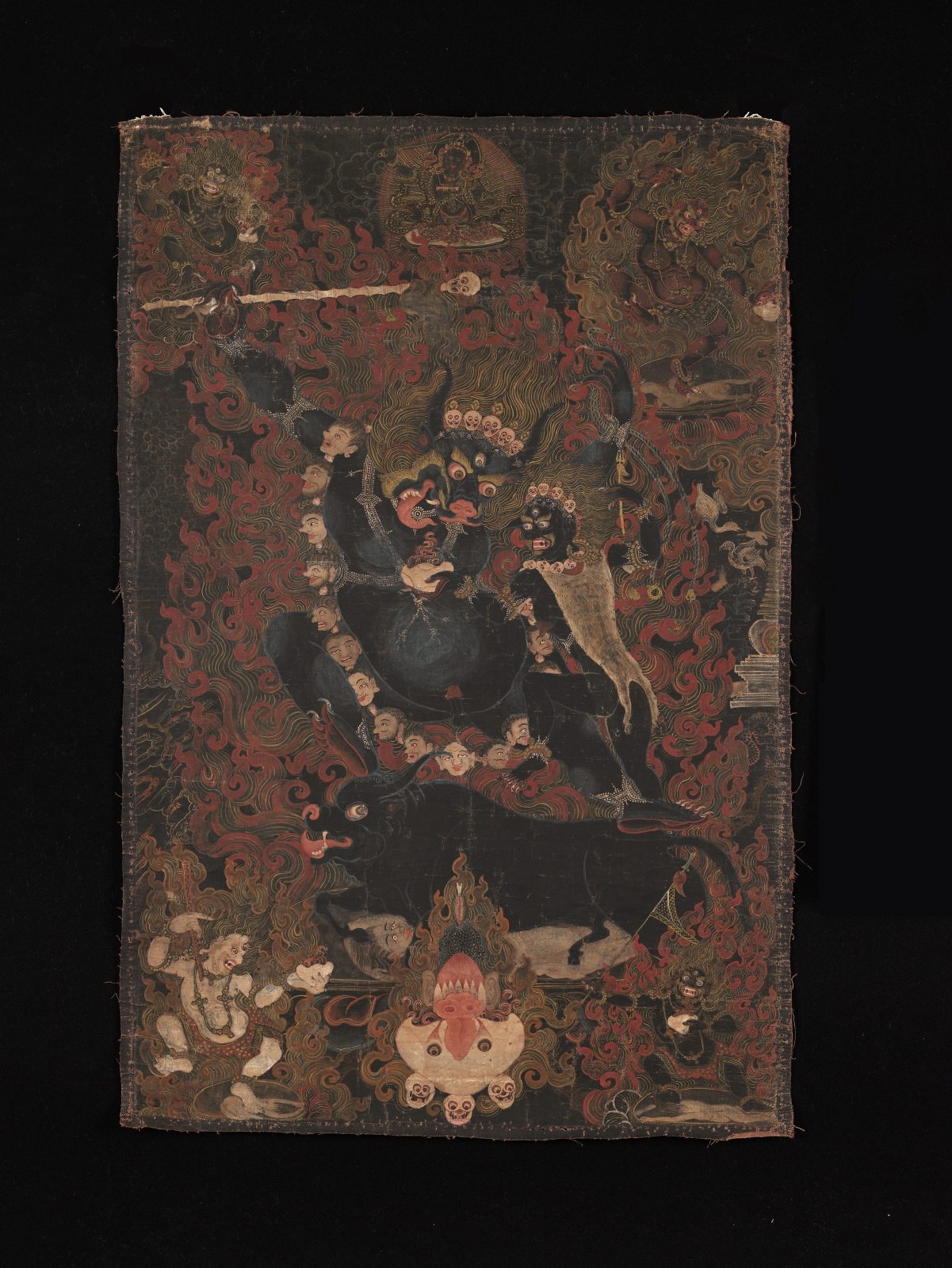
Yama Dharmaraja with Consort Yami; Tibet; 18th century; Pigment on cloth; Rubin Museum of Himalayan Art, Gift of Shelley and Donald Rubin; C2006.66.409
Yama Dharmaraja is one of several terrifying forms Bodhisattva Manjushri assumed to defeat the Lord of Death. He is black or dark blue in color, fiercely animated, and wields a skull-headed cudgel and a coiled lasso. Wearing a crown of skulls and a garland of freshly severed heads, he is surrounded by flames and stands astride a buffalo and human corpse.
This black-ground painting evokes the macabre setting in which Yama Dharmaraja resides: a corpse-strewn funereal ground. Around him are four wrathful figures from his entourage, each haloed by flames, dancing wildly on a body and clutching a gore-laden skull cup. In the foreground, an offering of organs associated with the five senses brims from a skull bowl. Sitting in a small eddy of tranquility above this visual torrent is Bodhisattva Manjushri, whose manifestation as the terrifying Yama Dharmaraja is the means for defeating death.
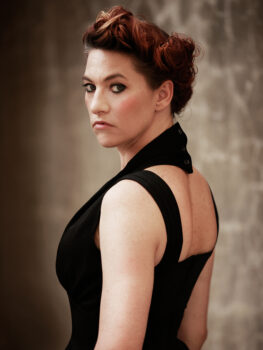
Amanda Palmer is a singer, songwriter, playwright, pianist, author, director, and blogger who simultaneously embraces and explodes traditional frameworks of music, theater, and art. She first came to prominence as part of the punk cabaret duo The Dresden Dolls, earning global applause for their inventive songcraft and wide-ranging theatricality. Her solo career has proven equally brave and boundless, featuring such groundbreaking works as the fan-funded Theatre Is Evil, which made a top 10 debut on the Billboard 200 in 2012 and remains the top-funded original music project on Kickstarter. Her 2013 TED talk “The Art of Asking” has been viewed over 20 million times worldwide. Palmer expanded her philosophy into the New York Times best-selling memoir The Art of Asking: How I Learned to Stop Worrying and Let People Help.
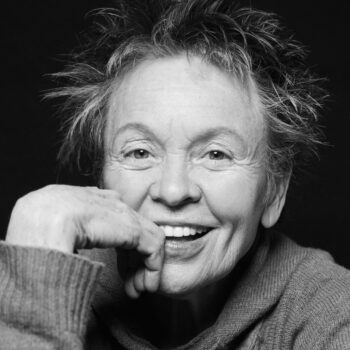
Laurie Anderson is one of America’s most renowned and daring creative pioneers. She is best known for her multimedia presentations and innovative use of technology. As writer, director, visual artist, and vocalist she has created groundbreaking works that span the worlds of art, theater, and experimental music. Ms. Anderson has published seven books, and her visual work has been presented in major museums around the world. In 2002 she was appointed the first artist-in-residence of NASA, which culminated in her 2004 touring solo performance The End of the Moon. Her film Heart of a Dog was chosen as an official selection of the 2015 Venice and Toronto Film Festivals and received a special screening at the Rubin Museum, where she joined in conversation with Darren Aronofsky. Ms. Anderson has made many appearances at the Rubin, and has been in conversation with Wim Wenders, Mark Morris, Janna Levin, Gavin Schmidt, Neil Gaiman, and Tiokasin Ghosthorse. She also hosted the premiere season of the Rubin’s AWAKEN podcast.
Get the latest news and stories from the Rubin, plus occasional information on how to support our work.